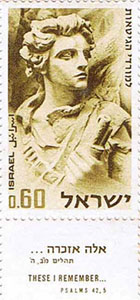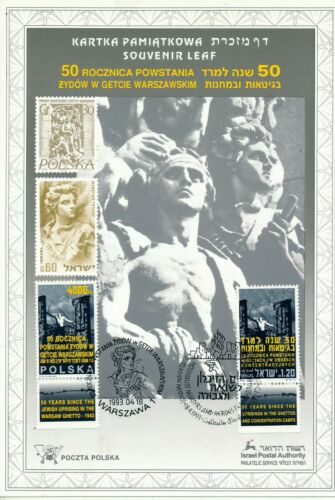|
On September 1, 1939, Nazi Germany attacked Poland and, on September 3, 1939, Britain and France declared war on Germany. That is how World War II began. On June 22, 1941, Germany invaded the Soviet Union and on December 7, 1941, Japan attacked the United States and the British colonies in the Far East. World War II spread throughout the globe. The warring parties: Britain, the Soviet Union, the United States and other countries that were the victims of the German occupation, and on the other hand: Germany, Italy, Japan and their countries of metastasis. Germany, beyond its aspirations for expansion in Europe, had another goal in this war, as Hitler said on January 30, 1939 in the Reichstag: The destruction of the Jewish race in Europe.
Despite the victories and conquests of Germany and Japan in the first years of the war, the military and economic power of the Allies decided. Germany surrendered on May 8, 1945, and Japan on August 14, 1945. The Second World War, in which 50 million people, soldiers and civilians were killed, including six million of our people murdered for being Jews, ended.
Jewish soldiers in the Allied armies
The Jewish people had a part in the victory over Germany. In the Allied armies about 1.5 million Jewish soldiers served and fought in the Soviet army, about 50,000 and 500,000 in the Soviet army, tens of thousands in the British Commonwealth armies, including some 40,000 volunteers from the Yishuv in Eretz Israel and other armies. Jewish soldiers served in all branches of the army - land, sea, and air; They fought in all the battlefields - Europe, North Africa, the Near East and the Far East; They served in all ranks - from private to admiral commanders, admirals and air force commanders. They were among the leaders in the development of weapons, which contributed greatly to victory. The position of Jewish women was also not absent in the forces of the servants.
Thousands of Jews were awarded medals of excellence, among them the highest: the Hero of the Soviet Union, the Medal of Honor of the United States Congress, and other insignia in the various armies. About a quarter of a million Jewish fighters fell in this war.
Jewish underground fighters and partisans
In the European countries occupied by Germany and especially in Eastern Europe, partisan resistance groups arose, who began a guerrilla war against the occupier. In the ranks of the partisans, tens of thousands of Jews fought. From their bases in the forests, the partisans attacked the German transport routes, smashed trains and blew up bridges. In the occupied cities, there were thousands of Jews among members and organizers of anti-Nazi undergrounds, including undergrounds that included Jews only. With few weapons, Jews raised the banner of revolt in the ghettos of Warsaw, Bialystok and others, and in the death camps of Auschwitz, Treblinka and Sobibor, knowing that they had no chance of winning.
At the end of the war, many of the Jewish soldiers, ghetto rebels and partisans, volunteers of the Jewish Yishuv in the British Army joined the struggle for the establishment of the State and were among the organizers of the escape and immigration to Eretz Israel. Tens of thousands of them fought in the War of Independence and were among the founders of the IDF and the State of Israel, and the Jewish fighters against Nazi Germany, who wrote a magnificent page in the history of our people, dedicated this series of stamps. (Written by Dr. Yitzhak Arad)
In the past, the Philatelic Service issued stamps commemorating the struggle of the Jewish people during World War II, including: Volunteerism (Paratroopers), 1955; The Yishuv volunteered for the British army (Brigade sergeant - Jewish fighting unit), 1979, the Holocaust and heroism - the ghetto uprising, 1983, 50 years of rebellion in the ghettos and camps - joint issue Israel-Poland, 1993.
Description of the stamp and the cover of the first day
In the stamp of the Jewish soldier in the Allied armies, a photograph of a parade of the fighters of the Jewish Brigade in the British Army is seen; As well as a Russian T34 tank, American B-17 bombers and a paratrooper. The Jewish soldier symbolizes the disks of an American-Jewish soldier and a Star of David medallion. The partisan and Jewish underground fighter's photo shows a photograph of a group of partisans; The underground fighter and the Jewish partisan symbolize the shape of a Star of David, created on a suit after the yellow star was torn from it. In the first day cover are the flags of the 22 Allied countries, the Star of David shape created on a suit and diskettes.
|
Yishuv volunteering for the British army during World War II
When World War II broke out in 1939, when the Yishuv numbered less than half a million people, it was decided to volunteer for war - despite the decrees of the "White Paper" issued by the Mandatory government following the Arab revolt of 1936-1939 - Death to the Zionist vision, as if there is no war.
The Yishuv wanted to establish Jewish units to be deployed to the front, but the army authorities objected and asked professionals and soldiers to guard the facilities.
The British mandatory government was not authorized to enlist, and the army could only be reached on a voluntary basis. There was a constant struggle over the recruitment track, and even an attempt not to recognize the Yishuv institutions that dealt with the volunteer arrangements they had announced. Despite the restrictions, a large-scale volunteer movement was established. At this stage of the war no one could know who would be the victor who would rule the world "in the next thousand years." It was not known where our soldiers might be sent during the war, which Japan had joined in the meantime. At the same time, neighbours were threatened by neighbours. It was dangerous and it was forbidden to leave the country without its young sons, and some of the youth was therefore obliged to remain in Israel and take part in guarding it, within the framework of the Yishuv's self-defense.
Under these circumstances, some 30,000 men and women volunteered for the British Army, Navy, and Air Force, and served in all the units whose insignia appear in the gallery. Many served in engineering, transport and infantry companies; Spread throughout the Middle East and North Africa (Iran, Iraq, Syria, Lebanon, Egypt, Libya, Eritrea, Somalia) and other areas; They also reached the bases of South Africa and Rhodesia; And later in the war found themselves in battles in Greece and Crete, also reached northern France and Denmark, camped in Malta, landed in Italy, and fought until the end of the campaign.
In the war, which lasted six years, two of every three soldiers spent most of their time in combat zones. On land and in the sea we counted more than 600 people. Some of our soldiers at the front of Greece had the taste of being captured by the Germans. About 430 people received medals for excellence. In Hebrew units, despite the British position, Jewish identity and heritage were formed over Jewish language, culture and culture; a sense of sovereignty developed before the state, when the hearts of the soldiers pulsed with the struggle against the White Paper in Israel. This development was also expressed in the independent Hebrew internal command. It was only towards the end of the war that the regiments were concentrated, and the Brigade (the Jewish Fighting Brigade) was established, which was equipped with a battle line in northern Italy against an elite German unit. It was the banner of volunteerism that earned us the entrance to the victory parade against the Nazi oppressor when the national flag was flown to the world three years before the establishment of the state.
A large number of volunteers from Eretz Israel were found upon the end of the battles in the European continent, about 5000 of them from the Brigade. Many had family members who had remained in Europe at the time, and the soldiers had spread across Europe to seek and act.
This was where the encounter with the scattered remnant of camps of displaced persons with no identity and where to turn and where to return took place. Here came hope, pulsed life saved, and She'erit Hapleitah focused on immigration to Israel.
Here, then, this public gathered the forces needed to battle the mass immigration. Pressure was created to find a solution, and the pressure of She'erith Hapleitah by the "Exodus" on the way added its own weight to the entire campaign that ultimately led to the United Nations resolution on the establishment of the Jewish state. There was no possibility of significant rescue during the war, and the unique nature of the only possible rescue was the one that was realized with the Yishuv volunteering for war.
Volunteering behind the title of volunteering for the British Army, culminating in a meeting with She'erith Hapleitah, is the historical drama in which the fate of the Jewish people, which found itself at a crossroads, An expression of the historical role played by the Jewish volunteers:
In the Second World War, the Yishuv in Eretz Israel contributed its full part to the struggle of the nations that seek freedom and peace against the forces of Nazi evil, and in the blood of its soldiers and efforts it gained the right to be counted among the founding nations of the United Nations. (General Shlomo Shamir)
In the photo: * an illustration showing a Brigada soldier teaching Hebrew to the children of She'erit Hapleitah prior to their immigration to Israel. * Symbols of the British army units to which the Yishuv volunteers joined (from right to left): Paratroopers, Commandos, Artillery, Navy, Maintenance, Palestine Regiment, Women's Auxiliary Corps, Air Force, Remy, General Service, Communication, Intelligence, Medicine, Corps Military rabbinate, transportation, military police, engineering. * The symbol of the Jewish Brigade - a Jewish Brigade. |
|
Warsaw Ghetto Uprising
 Commemorating twenty-five years of revolts in the ghettos and camps (1968), the upper part of the statue is commemorated in memory of Mordechai Anielewicz (1919-1943), commander of the Warsaw Ghetto Uprising, named after him. On the tab of the stamp appears a quote from the Scriptures: "These are the memorials" (Tehillim), 42, 5. Commemorating twenty-five years of revolts in the ghettos and camps (1968), the upper part of the statue is commemorated in memory of Mordechai Anielewicz (1919-1943), commander of the Warsaw Ghetto Uprising, named after him. On the tab of the stamp appears a quote from the Scriptures: "These are the memorials" (Tehillim), 42, 5.
The Warsaw ghetto rebels became the hallmark of Jewish resistance to the Nazis and their aides during the Holocaust.
The Nazis and their collaborators entered the Warsaw ghetto on April 19, 1943, with the aim of liquidating it. It was the eve of Passover. As soon as they reached the ghetto, they encountered heavy resistance from the Jewish fighters organized by both the ZZW and the ZOB. The rebels shot at the Germans and caused them heavy casualties. The following day, the surprised Germans adopted a new tactic: the burning of ghetto houses. On May 8, Mordechai Anielewicz was killed, and many of his commanding officers were killed, and others were killed, as long as the Germans did not fall into the hands of the Germans.
On the last day of the uprising, the Germans blew up the Great Synagogue in Warsaw. This symbolic move marks the end of the brave revolt.
The ruins of the Warsaw ghetto after the uprising are seen in a stamp commemorating the 50th anniversary of the uprising in the ghettos and camps, which was issued in a joint issue with Poland in 1993. The barbed wire fences around the extermination camps are visible on the stamp.

|